Wildflowers, Grasses and Other Nonwoody Plants
Media
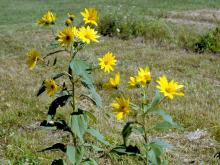
Species Types
Scientific Name
Helianthus tuberosus
Description
Jerusalem artichoke deserves a better common name. This tall native sunflower has edible tubers and great crop potential, but it has never been very big commercially. Fortunately, we can enjoy it for free in nature.
Media

Species Types
Scientific Name
Helianthus grosseserratus
Description
A giant of a wildflower, sawtooth sunflower reaches 16 feet in height and sometimes occurs in dense colonies of clumping stems. It has long, coarsely toothed, lance-shaped leaves with winged petioles.
Media

Species Types
Scientific Name
Arnoglossum atriplicifolium (also Cacalia atriplicifolia)
Description
The stout, smooth leaves of pale Indian plantain, with their glaucous-white coating beneath, look almost artificial. They are irregularly shaped, with pointed lobes. At the base of the plant, they can be 6 inches wide. They become gradually smaller up the stem.
Media

Species Types
Scientific Name
Silphium integrifolium
Description
Wholeleaf rosinweed looks like a sunflower, but its relatively small central disk of infertile florets reveals it as a rosinweed, genus Silphium. It occurs statewide.
Media
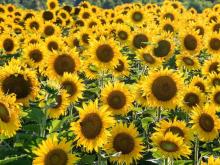
Species Types
Scientific Name
Helianthus annuus
Description
Whether you see the wild form or any of the many cultivated varieties, this poster child of the sunflower family cultivates its own sunny impression. Common sunflower is also the state flower of Kansas.
Media

Species Types
Scientific Name
Echinacea paradoxa
Description
Yellow coneflower is the only coneflower with yellow ray flowers, not pink or purplish ones, which explains the species name, paradoxa. Although cultivated statewide, this prairie and glade wildflower grows natively only in the Ozarks.
Media
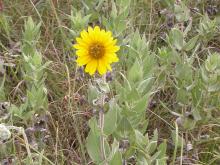
Species Types
Scientific Name
Helianthus mollis
Description
Ashy sunflower is relatively short compared to others in its genus. Its leaves are grayish, hairy, sessile, and broadly oval. Its colonies are common in upland prairies in the southern half of the state.
Media

Species Types
Scientific Name
Rudbeckia triloba
Description
Brown-eyed Susan is a bushy perennial with much-branching stems and plenty of flowerheads. Compared to Missouri’s other Rudbeckia species, its flowerheads are the smallest, growing to only about one inch across.
Media
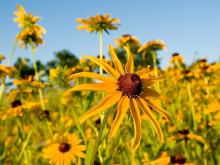
Species Types
Scientific Name
Rudbeckia hirta
Description
Black-eyed Susan is a tremendously popular native wildflower for gardening. It’s also commonly planted along roadways, so when it’s blooming, May through October, you’re sure to see it somewhere.
Media
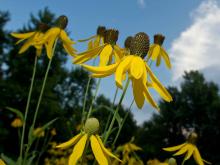
Species Types
Scientific Name
Ratibida pinnata
Description
The “disk” of gray-headed coneflower is an inch-long, round knob. It starts off gray, but as the disk florets open and bloom, it turns brown. It grows almost statewide in prairies, glades, pastures, fencerows, and roadsides.
See Also
About Wildflowers, Grasses and Other Nonwoody Plants in Missouri
A very simple way of thinking about the green world is to divide the vascular plants into two groups: woody and nonwoody (or herbaceous). But this is an artificial division; many plant families include some species that are woody and some that are not. The diversity of nonwoody vascular plants is staggering! Think of all the ferns, grasses, sedges, lilies, peas, sunflowers, nightshades, milkweeds, mustards, mints, and mallows — weeds and wildflowers — and many more!





















